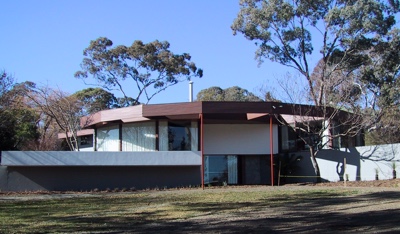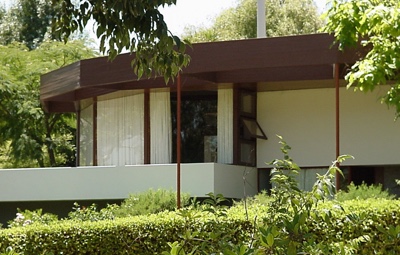10 Gawler Crescent, Deakin (1956)

10 Gawler Crescent, Deakin
The Benjamin House, or Round House as it is also known, at 10 Gawler Crescent, Deakin was designed by Alex Jelinek for Professor and Mrs Bruce Benjamin in 1956 and completed in 1957. Jelinek was a Czechoslovakian educated architect who migrated to Australia in 1950 to work on the Snowy Mountains Hydro Electricity scheme. He died at age 81 on 12 February, 2007.
Although it is circular rather than cubiform, the house is an example of the post-war international style with its large sheets of glass, structural frame expressed, cantilever and contrasting non-rectangular shape. It is a remarkable, complex design based on the Pythagorean spiral and was awarded ‘House of the Year for 1958’ by the editors of Architecture and Arts magazine.
The house also contains two pieces of specially designed and handcrafted dining room furniture by Schulim Krimper, one of Melbourne’s fine furniture makers of the 1940s and 1950s. An exhibition of Krimper’s work was held at the National Gallery of Victoria in 1959. More about Krimper below.
Significance
10 Gawler Crescent, Deakin, is listed on the ACT Chapter of the Australian Institute of Architects Register of Significant Twentieth Century Architecture and is regarded by the AIA as being of national significance. It is Canberra’s first truly sophisticated complex geometric design and arguably one of Canberra’s two most important post-war international style houses (the other being the Bowden House at 11 Northcote Crescent, Deakin).
It is possibly the only example of a complex geometric post-war international house in Australia. The radiating design that emanates from the central glass walled pool, forming asymmetrically varying rooms, is a technically complex achievement which has resulted in the play of forms and shapes in a geometric masterpiece.
Description
The house is set centrally on the large block, which slopes from the rear down to the street. Construction is of concrete blockwork, reinforced concrete walls and suspended slabs, timber framed floors and steel and timber roof framing with a membrane roof. The blockwork was originally exposed internally and externally.
A circular split level plan takes advantage of the sloping site. The house is designed around a radiating grid. The radiating structure and walls define the internal spaces: sixteen radiating segments set at 22.5 degrees are defined by the mahogany lined exposed roof beams, with three segments deleted to form the north west courtyard off the living area.
At the centre is a 1.4m diameter pool which is surrounded by full height curved glass supported by (but set in from) four circular steel posts which support the steel ring beam that accommodates the radiating structural roof frame. The roof slopes to this central structure where the pool acts as the roof’s storm water outlet.
The radiating form is further expressed at the roof edge, where the 570mm deep perimeter mahogany clad fascia is supported by mahogany clad radiating beams, the depth of the fascia, and by three steel posts. This perimeter fascia is reduced in depth around the bedrooms to express the hierarchy of the internal spaces.

The balcony off the living room
A dominant radiating wall extends out into the landscape, defining the entry. This is shown to superb effect in the Wolfgang Sievers photos of the Round House on the Trove website. The wall axis also cuts through the house to form the division between the dining room and the living room and courtyard. The balcony off the living room, facing west, cuts at a tangent to the outer circle of the house forming a cantilevered, rectilinear mass that provides a contrast with the curved and diagonal axial forms.
Entry is at ground level to the south, defined by the axial wall. The glazed entry lobby leads to an angled staircase, cutting across the diagonal axial wall and rising to the main level between the dining and living rooms, next to the pool. Arrival is thus at the centre of the house.
The living room occupies three segments, the north east wall being half glazed with a large timber framed sliding glass door. The south wall is set on the ‘Y’ axis and divides the room from the upper level study which is located over the entry. At the end of the wall is a suspended concrete fireplace which mirrors the curved glazing of the pool surround. The clear, smooth glazing contrasts with the solid, textured fireplace. Contrasting textures is an important element of the post-war international style. The continuation of the concrete wall forms the angled wall between the entry stair and the study. The room looks out to the west through full height faceted glass walls, each facet set on the grid.
The dining room is located beyond the pool opposite the living room and is defined by a curved wall set 3m from the centre of the pool. This wall divides the wet areas and bedrooms from the living areas. The dining room occupies six segments, with an outlook to the courtyard through a large sliding timber framed glazed door. The dining room furniture was designed by Krimper and has remained in the house since its construction, forming an important element of the interior. The built-in timber table is curved on a radius of 2.21m from the central pool, while the wedge shaped cabinet is perpendicular to the table and is placed in the radiating grid forming a divide from the passage.
The study, positioned over the entry, is a small asymmetrical room with the west external concrete wall spanning over the entry glazing. It originally looked out over the rear terrace, which was enclosed to form a family room in 1968, to a design by architects Moir and Slater.
Bedrooms and wet areas are located up three steps to the east, each bedroom occupying one segment of the grid. The corridor curves round between the bedrooms and the internally located bathroom, shower and toilet. The bedrooms have full width glazing and the wet areas are lit by skylights.
Schulim Krimper (1893–1971)
Schulim Krimper was born on 28 July 1893 in Bukovina, son of a rabbi. After apprenticeship as a cabinetmaker and service in the Austro-Hungarian army, he settled in Berlin in the early 1920s.
Krimper and his wife arrived in Melbourne in August 1939, establishing a workshop in St Kilda and becoming what the Australian Dictionary of Biography (Volume 15, p 42) describes as:
Melbourne’s premier supplier of custom made furniture in the modern style. His ability to reveal the beauties of his timbers was legendary, as was the finesse of construction of his furniture. He was the first cabinetmaker in Victoria to demand—and receive—for his craft the respect which had previously been accorded only to painters and sculptors.
The Krimper workshop had some of the flavour of a European atelier. On occasion he affected a beret, artists smock and monocle. He died on 18 August 1971. Krimper was the subject of exhibitions at George’s Gallery in 1951, the Rockefeller Centre in 1956 and the National Gallery in 1959 and 1975. His work is in the collections of the National Gallery of Australia, the Art Gallery of Queensland, the Art Gallery of South Australia and the Powerhouse Museum.
Apart from buildings in Canberra, he was associated with a number of sites in Melbourne, in particular the outstanding woodwork of the chapel at St Mary’s College, University of Melbourne, the sister institution of Walter Burley Griffin’s Newman College.
Source
- Australian Institute of Architects RSTCA Citation No. R112
- Conversations with the current owner, Dr Roger Benjamin